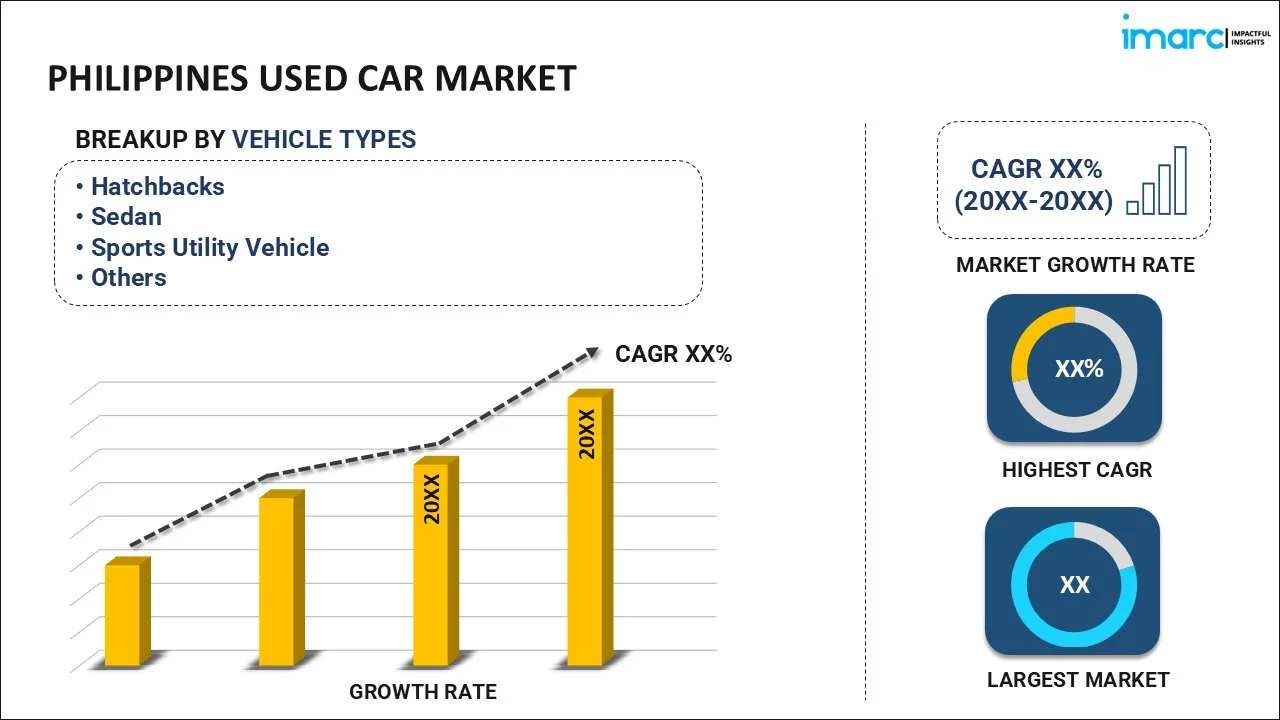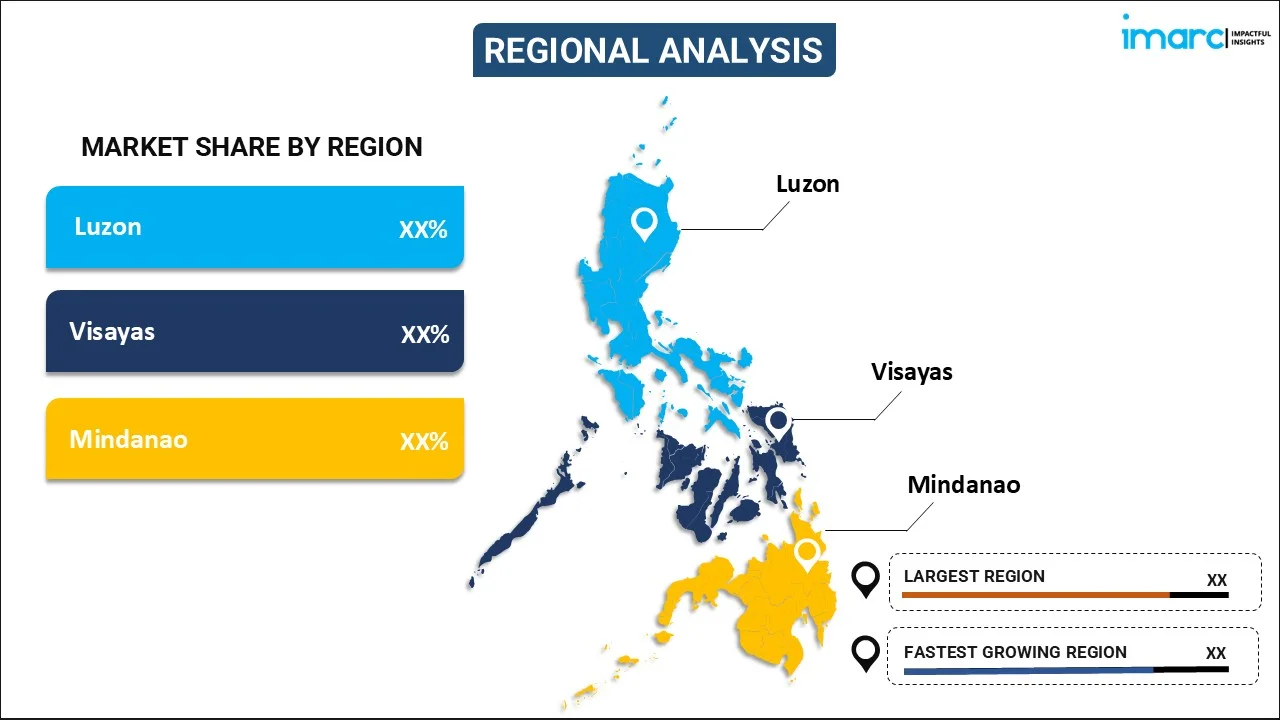
Philippines Used Car Market Size, Share, Trends and Forecast by Vehicle Type, Vendor Type, Fuel Type, Sales Channel, and Region, 2025-2033
Philippines Used Car Market Overview:
The Philippines used car market size reached 1.23 Million Units in 2024. Looking forward, IMARC Group expects the market to reach 2.03 Million Units by 2033, exhibiting a growth rate (CAGR) of 5.30% during 2025-2033. The Philippines used car market share is expanding, driven by the increasing implementation of government policies that facilitate vehicle import and encourage domestic production of vehicles, leading to a consistent influx of used cars, along with the expansion of digital marketplaces that offer car condition reports and easy financing options, making the entire process smoother and more transparent.
|
Report Attribute
|
Key Statistics
|
|---|---|
|
Base Year
|
2024 |
|
Forecast Years
|
2025-2033
|
|
Historical Years
|
2019-2024
|
| Market Size in 2024 | 1.23 Million Units |
| Market Forecast in 2033 | 2.03 Million Units |
| Market Growth Rate (2025-2033) | 5.30% |
Philippines Used Car Market Trends:
Increasing government support for automotive industry
The government’s support for the automotive industry is offering a favorable Philippines used car market outlook. In February 2025, the Department of Trade and Industry (DTI) unveiled a new incentive initiative, the Automotive Industry for Competitiveness Enhancement (RACE) program, aimed at enticing automotive firms to establish their manufacturing processes in the Philippines. The 2025 General Appropriations Act indicated that PHP250 Million was preliminarily allocated for the RACE program. Policies that ease the importation of vehicles and promote local manufacturing have resulted in a steady flow of cars into the market. This means that more cars, both new and used, are available for resale, giving users more options to choose from. The government agencies also have programs that encourage trade-ins, making it easier for people to upgrade to newer vehicles and make used cars more accessible to others. Additionally, some initiatives aim to improve infrastructure, which in turn helps to drive the demand for cars, including used ones. As new cars become more affordable through government incentives or lowered taxes, it also leads to more cars circulating, which eventually results in a larger supply of quality used cars. With these measures, the government agencies not only make cars more accessible to a wider range of individuals but also ensure the continuous flow of used vehicles into the market, keeping it active and competitive.
Expansion of online platforms
The expansion of online channels is impelling the Philippines used car market growth. More people are turning to the internet to buy and sell used cars because it offers convenience and a varied selection. E-commerce platforms have made it easier for buyers to browse through a variety of cars, compare prices, and find deals from both private sellers and dealers. This online shift reduces the hassle of physically visiting car lots and allows buyers to make informed decisions from the comfort of their homes. Moreover, digital marketplaces provide tools, such as car condition reports, financing options, and delivery services, which make the entire process smoother and more transparent. For sellers, these platforms provide greater exposure, allowing them to reach a wider audience across the country. With the broadening of e-commerce portals, people have become more confident in purchasing used cars online because they can easily check reviews, ratings, and certifications. As per industry reports, the e-commerce market in the Philippines is anticipated to expand consistently throughout the forecast period, achieving a CAGR of 11.38% from 2024 to 2028. The Gross Merchandise Value of e-commerce in the nation is expected to rise from USD 14.2 Billion in 2023 to USD 24.8 Billion by 2028.
Philippines Used Car Market Segmentation:
IMARC Group provides an analysis of the key trends in each segment of the market, along with forecasts at the regional level for 2025-2033. Our report has categorized the market based on vehicle type, vendor type, fuel type, and sales channel.
Vehicle Type Insights:

- Hatchbacks
- Sedan
- Sports Utility Vehicle
- Others
The report has provided a detailed breakup and analysis of the market based on the vehicle types. This includes hatchbacks, sedan, sports utility vehicle, and others.
Vendor Type Insights:
- Organized
- Unorganized
A detailed breakup and analysis of the market based on the vendor types have also been provided in the report. This includes organized and unorganized.
Fuel Type Insights:
- Gasoline
- Diesel
- Others
The report has provided a detailed breakup and analysis of the market based on the fuel types. This includes gasoline, diesel, and others.
Sales Channel Insights:
- Online
- Offline
A detailed breakup and analysis of the market based on the sales channels have also been provided in the report. This includes online and offline.
Regional Insights:

- Luzon
- Visayas
- Mindanao
The report has also provided a comprehensive analysis of all the major regional markets, which include Luzon, Visayas, and Mindanao.
Competitive Landscape:
The market research report has also provided a comprehensive analysis of the competitive landscape. Competitive analysis such as market structure, key player positioning, top winning strategies, competitive dashboard, and company evaluation quadrant has been covered in the report. Also, detailed profiles of all major companies have been provided.
Philippines Used Car Market News:
- In December 2024, CarDekho SEA, an auto financing service platform based in Singapore, secured USD 60 Million in equity, giving the company a valuation exceeding USD 300 Million, from Dragon Fund and Navis Capital Partners. The Southeast Asia division of India’s CarDekho Group aimed to utilize the funding to enhance its growth in Southeast Asia, concentrating on the financing of used cars and bikes in Indonesia and the used vehicle financing market in the Philippines.
- In December 2024, WowCar, a high-quality services provider in economy cars, revealed its launch in the Philippines. WowCar sought to provide a smooth, clear, and trustworthy platform for every participant in the used car industry. WowCar aimed to introduce its distinct combination of cutting-edge features, inventive tools, and a focus on user experience, establishing a fresh benchmark in the nation’s used car market.
Philippines Used Car Market Report Coverage:
| Report Features | Details |
|---|---|
| Base Year of the Analysis | 2024 |
| Historical Period | 2019-2024 |
| Forecast Period | 2025-2033 |
| Units | Million Units |
| Scope of the Report |
Exploration of Historical Trends and Market Outlook, Industry Catalysts and Challenges, Segment-Wise Historical and Future Market Assessment:
|
| Vehicle Types Covered | Hatchbacks, Sedan, Sports Utility Vehicle, Others |
| Vendor Types Covered | Organized, Unorganized |
| Fuel Types Covered | Gasoline, Diesel, Others |
| Sales Channels Covered | Online, Offline |
| Regions Covered | Luzon, Visayas, Mindanao |
| Customization Scope | 10% Free Customization |
| Post-Sale Analyst Support | 10-12 Weeks |
| Delivery Format | PDF and Excel through Email (We can also provide the editable version of the report in PPT/Word format on special request) |
Key Questions Answered in This Report:
- How has the Philippines used car market performed so far and how will it perform in the coming years?
- What is the breakup of the Philippines used car market on the basis of vehicle type?
- What is the breakup of the Philippines used car market on the basis of vendor type?
- What is the breakup of the Philippines used car market on the basis of fuel type?
- What is the breakup of the Philippines used car market on the basis of sales channel?
- What are the various stages in the value chain of the Philippines used car market?
- What are the key driving factors and challenges in the Philippines used car market?
- What is the structure of the Philippines used car market and who are the key players?
- What is the degree of competition in the Philippines used car market?
Key Benefits for Stakeholders:
- IMARC’s industry report offers a comprehensive quantitative analysis of various market segments, historical and current market trends, market forecasts, and dynamics of the Philippines used car market from 2019-2033.
- The research report provides the latest information on the market drivers, challenges, and opportunities in the Philippines used car market.
- Porter's five forces analysis assist stakeholders in assessing the impact of new entrants, competitive rivalry, supplier power, buyer power, and the threat of substitution. It helps stakeholders to analyze the level of competition within the Philippines used car industry and its attractiveness.
- Competitive landscape allows stakeholders to understand their competitive environment and provides an insight into the current positions of key players in the market.
Need more help?
- Speak to our experienced analysts for insights on the current market scenarios.
- Include additional segments and countries to customize the report as per your requirement.
- Gain an unparalleled competitive advantage in your domain by understanding how to utilize the report and positively impacting your operations and revenue.
- For further assistance, please connect with our analysts.
 Inquire Before Buying
Inquire Before Buying
 Speak to an Analyst
Speak to an Analyst
 Request Brochure
Request Brochure
 Request Customization
Request Customization




.webp)




.webp)












